Among the 2018 lineup for Safari Ltd. is everyone’s favorite sphenacodontid, Dimetrodon. This famous not-a-dinosaur was the T. rex of the Permian period and has been a pop-culture darling since its discovery. Even now it seems we’re treated to one of these flamboyant synapsids every couple years or so with Papo, Schleich, Favorite, and Recur all producing one within the last five years. A Dimetrodon from CollectA is due out this year too. The Papo Dimetrodon was a real treat– one of the best in their line. The Favorite Dimetrodon limbatus wasn’t bad either and while we can happily forget about Schleich’s attempt the Recur at least brought something new to the table. Some folks might lament the attention that Dimetrodon gets, while other bizarre Permian fauna get left in the dark. I would count myself among those folks, but I also welcome any model of a genus that’s well researched and well crafted. So how about it, does the Safari model stand out in the crowd?
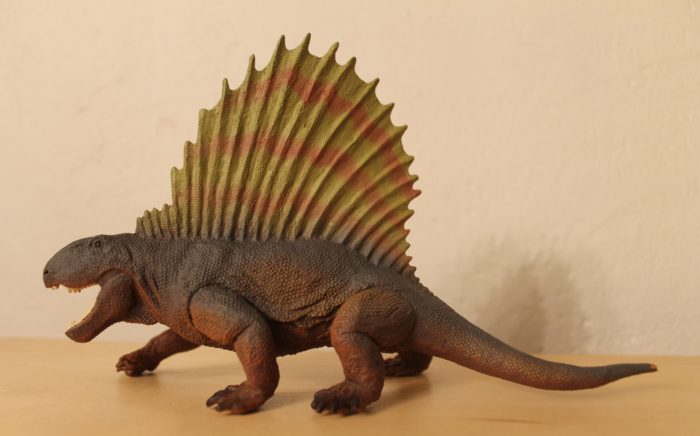
First off I must admit, I don’t know much about Permian synapsids. I’m a dinosaur fan-boy first and foremost. I have enough knowledge that I can impress a group of laymen fairly well (I know it’s not a dinosaur at least) but I confess that the thought of reviewing a Dimetrodon for the blog was somewhat intimidating. I took a crash course on the genus thanks to Wikipedia but I’m not about to pretend that I know more about this animal than its sculptor and his consultant. Doug Watson brings us this latest version of the genus and his consultant was none other than Dr. Robert Reisz, Professor of Paleontology at the University of Toronto. The wonderful skeletal drawing of Dimetrodon grandis by Scott Hartman served as a reference point for the sculpt.
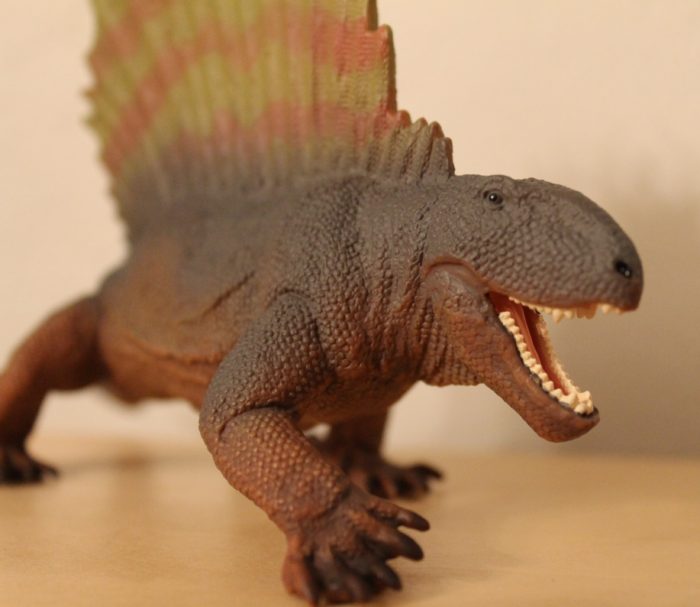
The thing with Dimetrodon is that it’s kind of a hard animal to reconstruct. Although classically envisioned as lizard-like in appearance and behavior this animal was no lizard. More akin to mammals than reptiles it wasn’t a mammal either. Non-mammalian synapsids are an odd group of animals that maybe looked like reptiles? Or maybe looked like mammals? It seems that the current trend is to reconstruct this animal as mammal-like, even going so far as to give it hair. The Safari model seems to handle this issue quite well, looking decidedly reptilian with a hint of its synapsid pedigree mostly conveyed in its posture and dynamism.
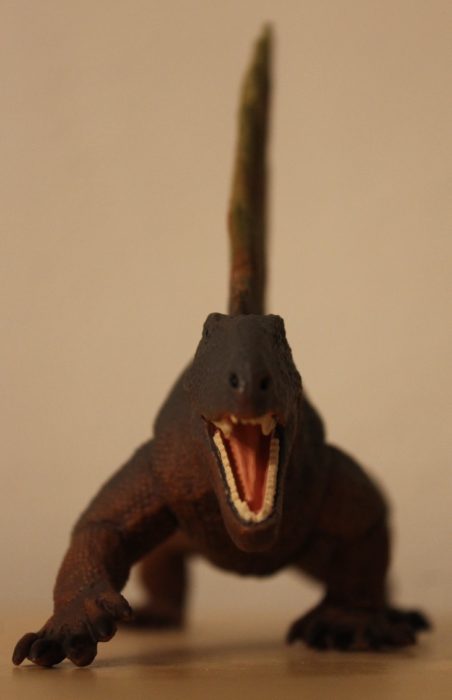
The Safari Dimetrodon is portrayed in a semi-sprawled posture striding forward with mouth open, as if it had just sprung out of some undergrowth to ambush an unfortunate prey item. Indeed, I think of these animals as somewhat crocodilian-like, laying motionless for much of the time but capable or tremendous bursts of speed. The right hindlimb propels the model forward with the forelimb stretched out ahead of the creature. The hands and feet look more like scaly bear paws than reptilian claws and I can imagine that a swipe from this particular animal could inflict a similar degree of damage.
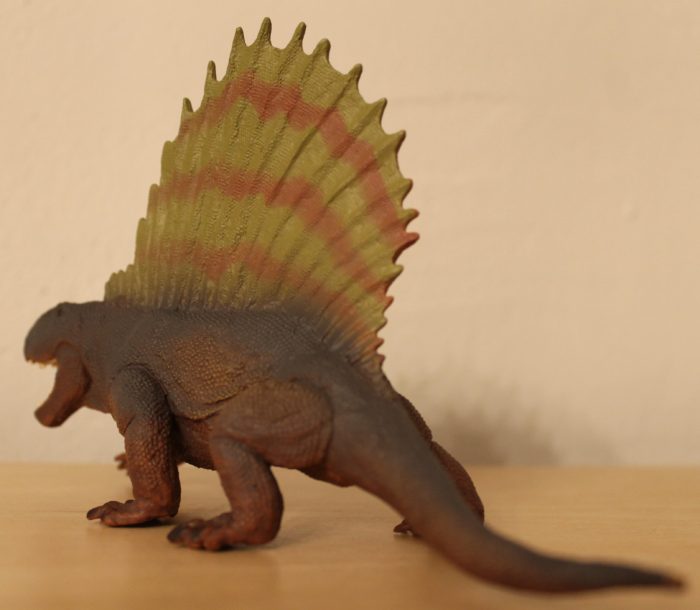
Anatomically the model succeeds well. The head is large, deep, and narrowly compressed. The teeth within its maw properly show the varying dentition that “two measures of teeth” aka Dimetrodon would have had. The neck is short, body robust, and tail sufficiently short as it would have been in the actual animal. Too many companies give Dimetrodon a longer tail than it would have had in life. Features like the lips and scaly hide were directly advised by Dr. Reisz.
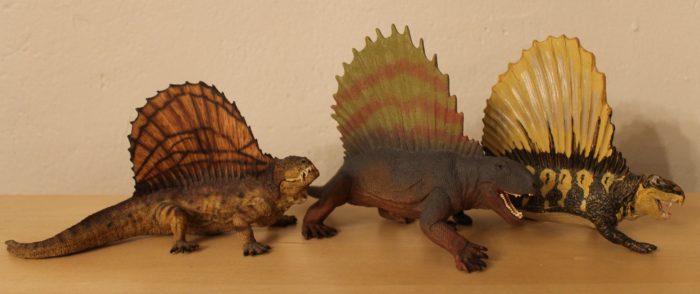
This Dimetrodon is muscular and husky with folds of skin hanging down its side. The strength conveyed in this figure conjure images of other powerful animals; both mammal and reptiles. Like a grizzly bear or Komodo dragon.
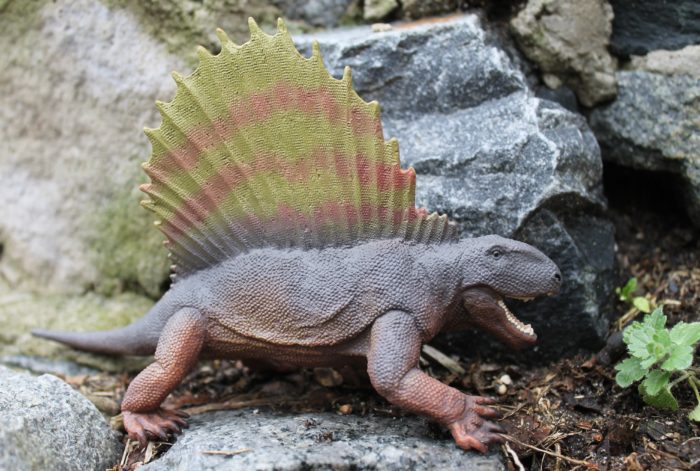
The paint scheme on the body is a subdued purplish brown, dark dorsally and fading to a lighter shade on the underside. It’s a realistic and non-traditional color choice that makes it easy to envision this creature hiding out in some dark forested environment. The sail, with drab green and faint purple bands is portrayed as a display feature without being gaudy. The nostrils and eyes are painted with a lifelike sheen that gives them the appearance of being wet. The tongue is pink, teeth white, and claws dark brown.
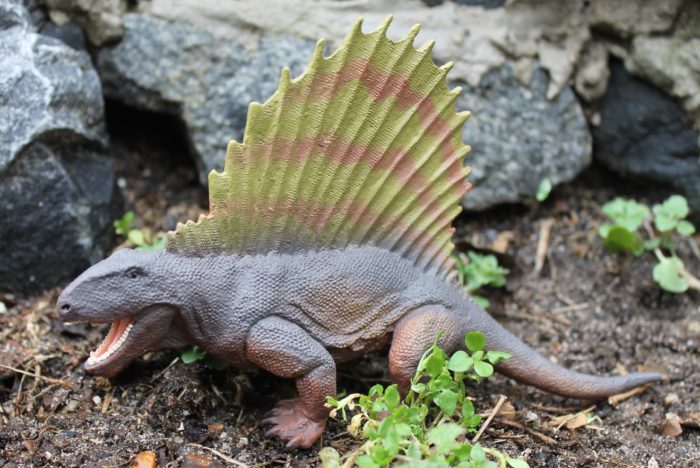
I have to admit that I was at first under whelmed by the idea of yet another Dimetrodon on the market. There are tons of other Permian synapsids in need of love. That said, this is a fantastic piece. I fell in love with it before I even had it in hand because unlike many past attempts at the genus this one gets it right. Other Dimetrodon figures all look a bit “off” by comparison, especially when viewed alongside a skeleton of the beast. I didn’t think it could get much better than the Papo Dimetrodon but this is the new benchmark for the genus. No matter how many Dimetrodon models adorn your shelf you should at least find enough room for just this one more, you won’t regret it! The Safari Dimetrodon is new for 2018 and should be easy to find, pick one up wherever Safari figures are sold!
Disclaimer: links to Ebay and Amazon on the DinoToyBlog are affiliate links, so we make a small commission if you use them. Thanks for supporting us!



This dimetrodon will make a good match with the Collecta dimetrodon. Especially the dimetrodon of Safari what Gwangi says his semi-upright posture, attitude that he did not observe in other figures of other brands.
Doug Watson knows how to make quality figures from the paleological eras of prehistory. It is an outstanding work from all points of view.
I feel like this is “less Gatorlike”and more” Monitor lizardlike”
Thanks for reviewing that figure. I was tempted to get it aswell, but for all its glory in detailing and accuracy, I’s wish it would show more mammalian features. Actually, I just read in a book from the late 70’s that Dimetrodon might aswell have had whiskers. Also, just from the collctor’s view, thanks for the comparison shot, but I think that figure is too big for my taste.
I am happy that we got two Dimetrodon figures for 2018, this one from Safari Ltd and the other one from CollectA. We have got two new perspectives of this prehistoric animal for 2018. I have the Papo Dimetrodon, Finally, the Papo Dimetrodon leaves the throne for Safari Ltd and CollectA’s 2018 Dimetrodon models. The coloration on the sail looks very much like the color scheme on CollectA’s version, without the purple bands. We have got plenty of Dimetrodon models, but this one and CollectA’s are must-haves! The Papo version and the Carnegie Dimetrodon models are not bad also. I am impressed with your review.
The Favorite Co. Dimetrodon that came out in 2015 actually represents D. limbatus,so there is some variety in Dimetrodon species out there right now.
Awesome, I did not know that. Thanks for pointing that out. Now I have to get it of course.
I am happy that we got two Dimetrodon figures for 2018, this one from Safari Ltd and the other one from CollectA. We have got two new perspectives of this prehistoric animal for 2018. I have the Papo Dimetrodon, Finally, the Papo Dimetrodon leaves the throne for Safari Ltd and CollectA’s 2018 Dimetrodon models. The coloration on the sail looks very much like the color scheme on CollectA’s version, without the purple bands. We have got plenty of Dimetrodon models, but this one and CollectA’s are must-haves! The Papo version and the Carnegie Dimetrodon models are not bad also.
Great review. I hope Safari gives us an Edaphosaurus in the future to complement this ferocious beast.
CollectA have confirmed that they are going to release an Edaphosaurus for 2019 to follow along with their Dimetrodon released this year.
Still, which is better?
The Safari Ltd 2018 Dimetrodon or the CollectA Dimetrodon?